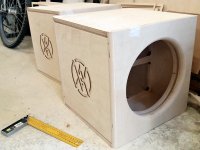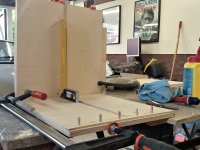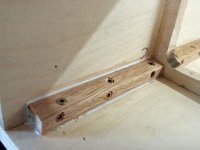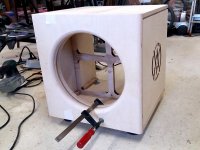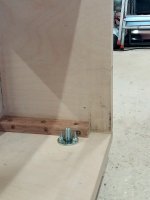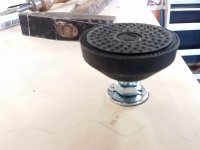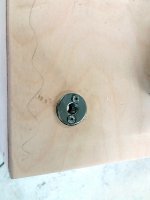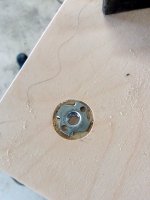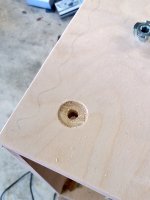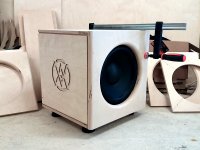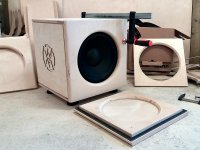I have them. They aren't as great as they look on paper. Just "OK"Why not look at the little Tectonic BMR 2" driver?
Great Xmax, flat FR, amazing dispersion, and better sensitivity than the ones you've shown.
Did someone say "power amps?"
If you want more than a few Watts of power, I would look at the Hypex modules. They are excellent, especially for subs, where you might need more than a few Watts. For the arrays, you gotta go Class A. I would do an F5 Turbo, in fact, I am going to build an F5 Turbo. I have the M2, and it is lovely on the arrays. The Hypex are excellent off-the-shelf options for the arrays as well. They sound superb.
If you want more than a few Watts of power, I would look at the Hypex modules. They are excellent, especially for subs, where you might need more than a few Watts. For the arrays, you gotta go Class A. I would do an F5 Turbo, in fact, I am going to build an F5 Turbo. I have the M2, and it is lovely on the arrays. The Hypex are excellent off-the-shelf options for the arrays as well. They sound superb.
I have them. They aren't as great as they look on paper. Just "OK"
New tech, so they still have room to grow.
Still, for an entry into new tech, they are pretty good. I've seen / heard much worse from first iterations.
They are pretty ideal for computer speakers, and small projects.
And given time to focus the design, maybe something special.
And I believe the project was for 100+ of them... that might be interesting!
Did someone say "power amps?"
If you want more than a few Watts of power, I would look at the Hypex modules. They are excellent, especially for subs, where you might need more than a few Watts. For the arrays, you gotta go Class A. I would do an F5 Turbo, in fact, I am going to build an F5 Turbo. I have the M2, and it is lovely on the arrays. The Hypex are excellent off-the-shelf options for the arrays as well. They sound superb.
re' You gotto go class A
Really? I was surprised to hear that until I read the F5 Turbo article - impressively low distortion and solid state, not tube based. Takes me back to my first EE class decades ago where we were presented with an over simplified view of amplifier design - just enough info to get us into trouble when let loose into industry.
Well I'm not shopping yet. This Goldmund Telos 400 clone does a lot right. 
I don't expect any change soon. The subs will be powered by Hypex 500 watt modules so that's covered too.
With the arrays playing full range, the control this amp has on those cones is impressive in the bass departement. However they really sing in the mid and upper range too. I might win even more with the subs added, but that really is hard to imagine right now. I still sit and listen with a huge grin on my face each time.
I don't expect any change soon. The subs will be powered by Hypex 500 watt modules so that's covered too.
With the arrays playing full range, the control this amp has on those cones is impressive in the bass departement. However they really sing in the mid and upper range too. I might win even more with the subs added, but that really is hard to imagine right now. I still sit and listen with a huge grin on my face each time.
Progress is slow, but at least there is some progress 
Baffle fit test:
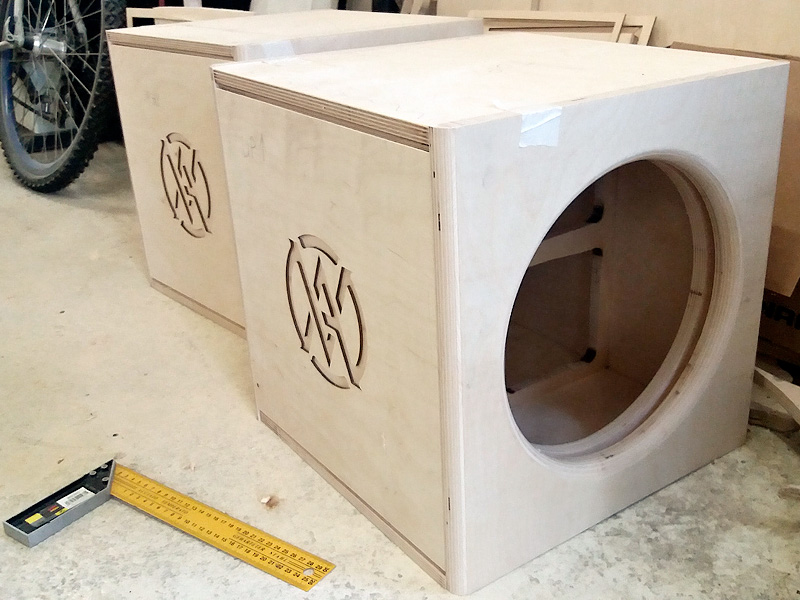
Adding dowel pins:
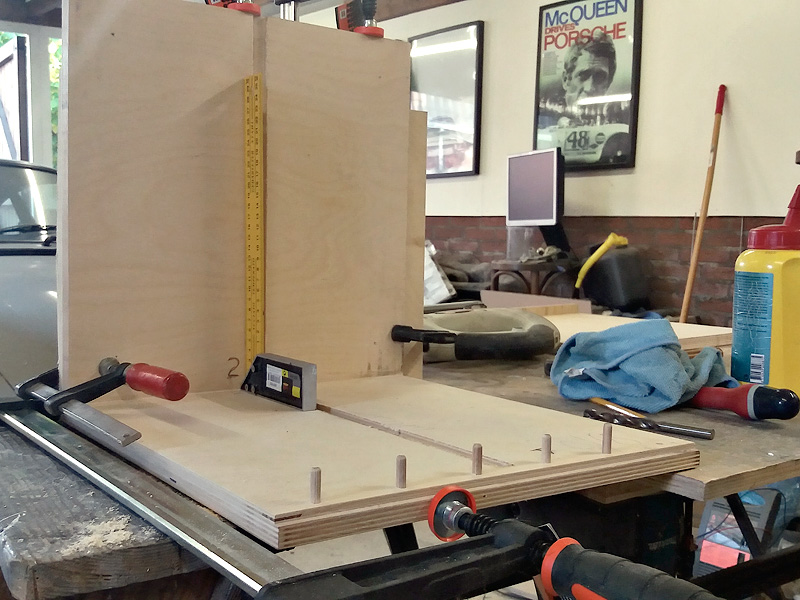
But also bolted and glued:
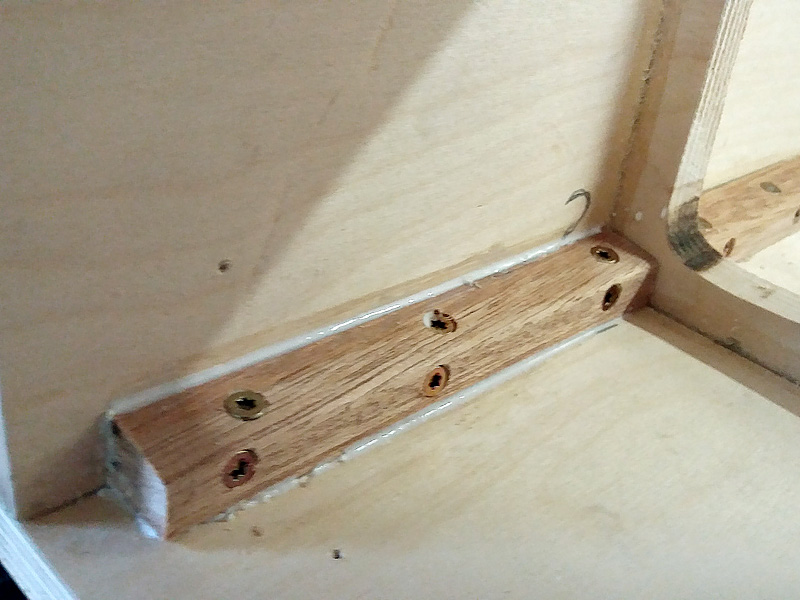
Clearly seen here I didn't take the time to make the inner brace as neat as the outside (lol). Just a quick jig-saw job, as long as the outer dimensions were up to spec.
Baffle fit test:
Adding dowel pins:
But also bolted and glued:
Clearly seen here I didn't take the time to make the inner brace as neat as the outside (lol). Just a quick jig-saw job, as long as the outer dimensions were up to spec.
Attachments
Last edited:
Those look fantastic! Nice job on the t-nuts, very belt-and-suspenders of you to do.
Got any details on those feet? I wonder if they would be easily available here in the states? I'm going to build cabs soon and they look perfect.

I had ordered some machine type feet for the arrays quite a while back. Before using those I started out with "poor man spikes" (cap nut on a bolt) and this damped foot was quite an improvement! It still has a sphere shape into a cup, but this time the cup is on a damping rubber layer before contacting the floor.
That specific model was discontinued so I started looking around and found an alternative here: Leveling feet nylon swiveling with ball joint
(sorry no brand and model numbers)
They were quite a bit cheaper and very similar to my original feet. Only this time I ordered the bigger 60 mm feet to give them some body to look at. I used M10 threads x 50 mm, model d60. Meaning it has a ball in a socket type construction with a rubber damping inlay. Very neat for such a small price. One of them can carry 350+ Kg.
Ronald, how are you planning to attach the woofer beauty panel? Exposed or hidden fasteners? Magnets?
Edit: I’m assuming you plan to allow access for servicing the woofer should that be necessary.
The plan is a hidden solution. The beauty panel is 1x 18mm Birch Ply external and 1x 15 mm internal. The plan is to weld some T-nuts to threaded rods and fix that (8x) to the 15 mm panel. Add some space on the inside of the outer panel for the T-nuts to (just) sink in and glue both together. So now I have a 23 mm outer baffle with about 8 threaded rods sticking out.
Next the threaded rods run trough the enclosure and will be fix with external nuts at the back panel. So they will hold the internal woofer baffle in place too, with separate nuts there. They are mounted with MLV rubber gaskets on both sides of the enclosure. Sort of a floating baffle.
I've been up and down with this idea, but yes, I want to have full access if needed for maintenance. I could easily do it a hundred other ways, but this seemed like a simple enough solution as I have an electric welder.
All other things I came up with had a need for even more internal panels etc.
I must have stared at the sub as pictured for about 15 minutes, trying to come up with a clever solution not involving the threaded rods (I have them already though). But that still means exposed nuts or bolts at the back side.
The rods is a (one rod) fit(s)-all solution, clean from the front and the back nuts can sport some mounting brackets to mount the amplifier on the back or at the (rear) side (hidden behind the array).
Last edited:
Plans for a new line array build
At last I have come to the end of this amazing thread!! I've spent a few hours each day the last week reading though it from the start, taking lots of notes. An amazing build with so much info and shared experience from the build and all those experiments.
The reason I got here is that me and my family in about six months will be moving to a new house and I have the opportunity to plan for a new listening area in our new living room. My current speaker, a WMTMW configuration I made some years ago, will simply take up to much space and I got the idea to build something with a less footprint integrated in the corners of the room on each side of a full wall book shelf, and at the same time getting the "best" sound of my life While browsing around I ended up here and...wow!
While browsing around I ended up here and...wow!
My plan so far is to use 28 drivers a side, which will cover the full height of the room. It will be some time before I can actually start building the speakers, as the house is going through a total makeover for a few months at least. Wesayso and others have been so friendly answering questions here so I hope it is ok to ask some of my own as the work progresses. In time I will start my own building thread.
So, a few questions already:
I have a hard time deciding in signal/eq chain. As the setup will be serving not only my own listening sessions, but also as the main TV/entertaining setup for the rest of my family, I need lots of inputs from different sources to be handled by the eq (as for now a TV box, playstation, nintendo, CD player, a Bluesound music streamer, an Apple TV for movie rentals/Netflix...). Running JRiver on a computer seems a good choice, but it would be acting as a EQ/processor only and not a media source. I read somewhere that ASIO line-in could be used, but then I need some way to get all these media sources routed that way. Another solution I figured could be the Ultimate preamp, but at a significant cost. And, besides, I already have an 8 ch Buffalo DAC I put together a few years ago. Any advice on this?
I have a few meters behind the listening spot to the back wall, so no very early reflections from that directions. Do you still think it would be a good thing to use the ambience speakers? As I understood, the your first reason to use Haas kickers was to create new "reflection" later in time to make the room sonically bigger?
Regarding the phantom center, I am thinking of using some kind of center speaker in order to fill the interference dips at a few kHz and up to improve the phantom center. I know you have been thinking about this also. How would you do to implement this? Do you think a single Vifa TC9 would do the job?
That is all for now, but I'm sure there will be lots of more questions later on..
Thank you again so much wesayso for sharing all this information, as well as you others that have been contributing so much in this thread.
Best regards,
Mattias
At last I have come to the end of this amazing thread!! I've spent a few hours each day the last week reading though it from the start, taking lots of notes. An amazing build with so much info and shared experience from the build and all those experiments.
The reason I got here is that me and my family in about six months will be moving to a new house and I have the opportunity to plan for a new listening area in our new living room. My current speaker, a WMTMW configuration I made some years ago, will simply take up to much space and I got the idea to build something with a less footprint integrated in the corners of the room on each side of a full wall book shelf, and at the same time getting the "best" sound of my life
My plan so far is to use 28 drivers a side, which will cover the full height of the room. It will be some time before I can actually start building the speakers, as the house is going through a total makeover for a few months at least. Wesayso and others have been so friendly answering questions here so I hope it is ok to ask some of my own as the work progresses. In time I will start my own building thread.
So, a few questions already:
I have a hard time deciding in signal/eq chain. As the setup will be serving not only my own listening sessions, but also as the main TV/entertaining setup for the rest of my family, I need lots of inputs from different sources to be handled by the eq (as for now a TV box, playstation, nintendo, CD player, a Bluesound music streamer, an Apple TV for movie rentals/Netflix...). Running JRiver on a computer seems a good choice, but it would be acting as a EQ/processor only and not a media source. I read somewhere that ASIO line-in could be used, but then I need some way to get all these media sources routed that way. Another solution I figured could be the Ultimate preamp, but at a significant cost. And, besides, I already have an 8 ch Buffalo DAC I put together a few years ago. Any advice on this?
I have a few meters behind the listening spot to the back wall, so no very early reflections from that directions. Do you still think it would be a good thing to use the ambience speakers? As I understood, the your first reason to use Haas kickers was to create new "reflection" later in time to make the room sonically bigger?
Regarding the phantom center, I am thinking of using some kind of center speaker in order to fill the interference dips at a few kHz and up to improve the phantom center. I know you have been thinking about this also. How would you do to implement this? Do you think a single Vifa TC9 would do the job?
That is all for now, but I'm sure there will be lots of more questions later on..
Thank you again so much wesayso for sharing all this information, as well as you others that have been contributing so much in this thread.
Best regards,
Mattias
Last edited:
Speaking of centre channel speakers, I have often wondered about the feasibility of using a pair of small wide-but-not-full range speakers, one in the centre above the screen and one below, so the phantom image created would be in the centre of the screen. Has anyone had success with this configuration?
If this is seen as a derailment, I am happy to start another thread on the subject.
If this is seen as a derailment, I am happy to start another thread on the subject.
Indeed I've been playing with the idea to use "something" in the center. I'm just still trying to figure out what.
I figured I better finish the subwoofers first and next do some experimental setups to find out what works and what doesn't.
If used for phantom enhancement only, the required frequency response would start at about ~1K.
I'm reluctant to answer what would be needed. As I have a desire to keep it as small as possible I've thought about using rugged tweeters, I might even do a small finite array.
One driver up and one below the screen could work if they are equal distance to the listening position on average. But there's a risk it would create a noticeable combing (from only 2 speakers) if you are above or below the listening "sweet-plane".
I figured I better finish the subwoofers first and next do some experimental setups to find out what works and what doesn't.
If used for phantom enhancement only, the required frequency response would start at about ~1K.
I'm reluctant to answer what would be needed. As I have a desire to keep it as small as possible I've thought about using rugged tweeters, I might even do a small finite array.
One driver up and one below the screen could work if they are equal distance to the listening position on average. But there's a risk it would create a noticeable combing (from only 2 speakers) if you are above or below the listening "sweet-plane".
Hi Mattias,
It takes dedication, to get trough this thread! It's a good thing to show/have such dedication skills as you're going to need it to build the arrays! Welcome aboard!
It's a good thing to show/have such dedication skills as you're going to need it to build the arrays! Welcome aboard!
You have a lot of input needs! I'm not sure I could really answer this one, as I've been playing computer sources only. Netflix wasn't a problem with FIR filters but I had to adjust sync at each start of a movie/series. I never tried to play it from within JRiver though, I just used the JRiver audio driver for playback. (the same one used for REW measurements)
I guess what I would do if I had such needs is to have 2 separate "zones" in JRiver, one dedicated to music listening and one for less demanding sources. That last one could be used without timing correction and stream movies, support the Playstation and similar inputs. All you'd need is a good input selector to connect to the line in.
I decided to make things as simple as I could by using PC source (read JRiver) for everything I needed. From my Car Audio days I was relieved not to mess with CD's anymore, just playing whatever I want to play without the hassle.
While movies take up a lot of space if you want to play it all from hard-drive I mainly used it for my son's collection and some classics for myself. The Nas helps out there with quite some storage capabilities. At the time I started with JRiver, to play DVD's there was no other option than to "store" a copy on hard-disk. As sync for latency did not work with DVD playback at that time due to restrictions in the DVD protection scheme. As the collection wasn't that big at that time I opted to store everything. Well that ended up with the need to get a Nas once I moved on to Blue Ray.
I never bothered to look back if things changed over time with playback from DVD/Blue Ray. I just store everything in MKV format. I found a couple of easy to use tools to do that.
(*) - I played movies and music from JRiver well before I finished the arrays as a way to prepare myself for the tools I needed to adjust the arrays. Even in those days I tried many things to get to grips with what was needed. That's when I was still using DVD only as source. Once I moved to Blue Ray the needed capacity went up quickly.
Yes, I do think it can still have it's advantages. Primarily because you can actually adjust the reflected energy, both in time and frequency spectrum.
It is correct I use it to hide my room and "project" a better one on top.
It definitely is a plus to have them double as surround speakers for movies. I adjust everything according to HT specs as much as I can. The ambience speakers (10F) cannot reach as low as they should but that was a problem mainly for playing Quad (pure 4 channel) sources. It never bothered me with movies.
That question has had a preliminary answer... I wouldn't dare to predict anything. "Don't assume, measure!" has been my motto .
.
Anyways it has been my pleasure to share this info on here, as I've got so much in return from it as well!
It takes dedication, to get trough this thread!
I have a hard time deciding in signal/eq chain. As the setup will be serving not only my own listening sessions, but also as the main TV/entertaining setup for the rest of my family, I need lots of inputs from different sources to be handled by the eq (as for now a TV box, playstation, nintendo, CD player, a Bluesound music streamer, an Apple TV for movie rentals/Netflix...). Running JRiver on a computer seems a good choice, but it would be acting as a EQ/processor only and not a media source. I read somewhere that ASIO line-in could be used, but then I need some way to get all these media sources routed that way. Another solution I figured could be the Ultimate preamp, but at a significant cost. And, besides, I already have an 8 ch Buffalo DAC I put together a few years ago. Any advice on this?
You have a lot of input needs! I'm not sure I could really answer this one, as I've been playing computer sources only. Netflix wasn't a problem with FIR filters but I had to adjust sync at each start of a movie/series. I never tried to play it from within JRiver though, I just used the JRiver audio driver for playback. (the same one used for REW measurements)
I guess what I would do if I had such needs is to have 2 separate "zones" in JRiver, one dedicated to music listening and one for less demanding sources. That last one could be used without timing correction and stream movies, support the Playstation and similar inputs. All you'd need is a good input selector to connect to the line in.
I decided to make things as simple as I could by using PC source (read JRiver) for everything I needed. From my Car Audio days I was relieved not to mess with CD's anymore, just playing whatever I want to play without the hassle.
While movies take up a lot of space if you want to play it all from hard-drive I mainly used it for my son's collection and some classics for myself. The Nas helps out there with quite some storage capabilities. At the time I started with JRiver, to play DVD's there was no other option than to "store" a copy on hard-disk. As sync for latency did not work with DVD playback at that time due to restrictions in the DVD protection scheme. As the collection wasn't that big at that time I opted to store everything. Well that ended up with the need to get a Nas once I moved on to Blue Ray.
I never bothered to look back if things changed over time with playback from DVD/Blue Ray. I just store everything in MKV format. I found a couple of easy to use tools to do that.
(*) - I played movies and music from JRiver well before I finished the arrays as a way to prepare myself for the tools I needed to adjust the arrays. Even in those days I tried many things to get to grips with what was needed. That's when I was still using DVD only as source. Once I moved to Blue Ray the needed capacity went up quickly.
I have a few meters behind the listening spot to the back wall, so no very early reflections from that directions. Do you still think it would be a good thing to use the ambience speakers? As I understood, the your first reason to use Haas kickers was to create new "reflection" later in time to make the room sonically bigger?
Yes, I do think it can still have it's advantages. Primarily because you can actually adjust the reflected energy, both in time and frequency spectrum.
It is correct I use it to hide my room and "project" a better one on top.
It definitely is a plus to have them double as surround speakers for movies. I adjust everything according to HT specs as much as I can. The ambience speakers (10F) cannot reach as low as they should but that was a problem mainly for playing Quad (pure 4 channel) sources. It never bothered me with movies.
Regarding the phantom center, I am thinking of using some kind of center speaker in order to fill the interference dips at a few kHz and up to improve the phantom center. I know you have been thinking about this also. How would you do to implement this? Do you think a single Vifa TC9 would do the job?
That is all for now, but I'm sure there will be lots of more questions later on..
Thank you again so much wesayso for sharing all this information, as well as you others that have been contributing so much in this thread.
Best regards,
Mattias
That question has had a preliminary answer... I wouldn't dare to predict anything. "Don't assume, measure!" has been my motto
Anyways it has been my pleasure to share this info on here, as I've got so much in return from it as well!
Last edited:
Hi Mattias,
You have a lot of input needs! I'm not sure I could really answer this one, as I've been playing computer sources only. Netflix wasn't a problem with FIR filters but I had to adjust sync at each start of a movie/series. I never tried to play it from within JRiver though, I just used the JRiver audio driver for playback. (the same one used for REW measurements)
I guess what I would do if I had such needs is to have 2 separate "zones" in JRiver, one dedicated to music listening and one for less demanding sources. That last one could be used without timing correction and stream movies, support the Playstation and similar inputs. All you'd need is a good input selector to connect to the line in.
Thank you wesayso! I noticed that our TV has an SPDIF optical out, so I would be able to route all signals from the gear connected to the TV out to the computer. This will mean, I guess, that I will be limited to stereo (no surround sound) for movies etc. Maybe I could live with that - as I remember you experienced a good center dialog with your towers without a dedicated center speaker, and the ambience speakers should be able to reproduce a good "atmosphere" using L-R/R-L signals. In that case I could probably use some input selector to select between TV and my music streamer and feed that signal to JRiver.
As I will build a big book shelf covering the wall, with the arrays integrated on the sides, I will probably leave some space for a center speaker in the future. My thinking was to route the mid-signal >1 KHz to that speaker, and cut out some of that signal from the arrays. Yes, there some measurement will surely be needed...
Another thing I didn't fully get: do you use FIR only for phase correction or frequency correction also? As i remember you had a pré eq (IIR) to get the FR in range for the DRC to handle and then also apply som post EQ (IIR?) for tweaking of the FR?
Pré EQ is used to get a reasonably flat result to send to DRC-FIR for processing.
DRC-FIR is used to correct both frequency and phase. The excess phase removal part of DRC-FIR only works up till 1 KHz. (EPEndFreq = 1000)
So, yes, DRC is used to correct frequency and phase.
The post EQ is to balance the left and right channel and to get my preferred tonal balance. That's all IIR. I also EQ a bit based on waterfall and IR info but see it as part of this balancing process. I used to have hundreds of tweaks in post EQ, now I'm down to about 50 (lol). All are based on the information of sliding frequency dependent windows and still influence the imaging perception a great deal (as far as left/right balance goes but also focus of the phantom centre).
As I tend to put tonal balance high up on my priority list (actually its on top) I have to split processing somewhat between DRC (only active for the first wave front, mostly speaker correction) and room (included in post EQ room working towards a room-curve).
Tonal balance is derived from a longer time window than imaging, but both need a frequency dependent sliding window. Just of different lengths. It is and will always be a balancing act but you can get both. The less influence you get from the room, the closer the frequency spectrum is to that first wave front.
You can't really EQ out a bad room, but you can get a proper tonal balance in a decent one. Even the ambient speakers can influence this part in a positive way.
The mid/side EQ (does it ever end ) is linear phase.
) is linear phase.
Pano has done a great job to make sense of it in this schematic:

It doesn't show the pré and post EQ and Convolution as separate units (all reside in the Main EQ block), but does show that mid/side EQ should always be done prior to any other form or shape of EQ.
P.S. I've watched many movies with the above scheme and it was very close to being as enjoyable as true surround. It gets you into the movie. That's the main point.
DRC-FIR is used to correct both frequency and phase. The excess phase removal part of DRC-FIR only works up till 1 KHz. (EPEndFreq = 1000)
So, yes, DRC is used to correct frequency and phase.
The post EQ is to balance the left and right channel and to get my preferred tonal balance. That's all IIR. I also EQ a bit based on waterfall and IR info but see it as part of this balancing process. I used to have hundreds of tweaks in post EQ, now I'm down to about 50 (lol). All are based on the information of sliding frequency dependent windows and still influence the imaging perception a great deal (as far as left/right balance goes but also focus of the phantom centre).
As I tend to put tonal balance high up on my priority list (actually its on top) I have to split processing somewhat between DRC (only active for the first wave front, mostly speaker correction) and room (included in post EQ room working towards a room-curve).
Tonal balance is derived from a longer time window than imaging, but both need a frequency dependent sliding window. Just of different lengths. It is and will always be a balancing act but you can get both. The less influence you get from the room, the closer the frequency spectrum is to that first wave front.
You can't really EQ out a bad room, but you can get a proper tonal balance in a decent one. Even the ambient speakers can influence this part in a positive way.
The mid/side EQ (does it ever end
Pano has done a great job to make sense of it in this schematic:

It doesn't show the pré and post EQ and Convolution as separate units (all reside in the Main EQ block), but does show that mid/side EQ should always be done prior to any other form or shape of EQ.
P.S. I've watched many movies with the above scheme and it was very close to being as enjoyable as true surround. It gets you into the movie. That's the main point.
Last edited:
To clarify a few things: you can never get back true left and true right channel info from a stereo source. All tweaks done there are soft EQ tweaks.
Even the center info always contains left and right info, basically being a mono (L+R) signal.
Only Home Theatre or 5.1 and above has the freedom to truly have separate left, right and center info.
I only use it to combat the tonal balance difference and as a perception tweak of the phantom center compared to the sides. It does work wonderfully well though.
Spend some time listening to the MSED plugin in various ways. Even listen to one speaker in mono for a while to pick up what each format does.
Another thing to note is that I aim to get a minimum phase band pass behaviour out of these arrays as seen from the listening position. That's why the excess phase is running on the bottom end only. The rest is IIR aside from those mid/side tweaks.
Even the center info always contains left and right info, basically being a mono (L+R) signal.
Only Home Theatre or 5.1 and above has the freedom to truly have separate left, right and center info.
I only use it to combat the tonal balance difference and as a perception tweak of the phantom center compared to the sides. It does work wonderfully well though.
Spend some time listening to the MSED plugin in various ways. Even listen to one speaker in mono for a while to pick up what each format does.
Another thing to note is that I aim to get a minimum phase band pass behaviour out of these arrays as seen from the listening position. That's why the excess phase is running on the bottom end only. The rest is IIR aside from those mid/side tweaks.
That is a very interesting diagram. Is it all done in JRiver? If so, I'd love to see the script that configures JR to do that and if so, just enough to get started on using a script for the purpose instead of going through the menus "manually". I'm sure you have a good solution.
- Home
- Loudspeakers
- Full Range
- The making of: The Two Towers (a 25 driver Full Range line array)
